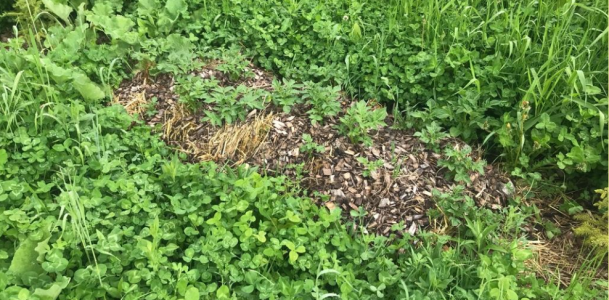Sedge and horsetail. Calacitic lime and gypsum. Potatoes? There's a deeper story for you to tell about why those things. What do you know about your soil(s) that leads you to this remedy? Please? I think it would be an interesting read if you would be so kind!
I dug a small water hole/pond and needed some place to go with the spoils. I brought up pure clay from six feet down (4 inches of topsoil), smeared it out, and planted clover and rye on top of it. That was in 2019. To this day, winter rye does not take on that soil, and I don't know why. I suspect excessive compaction becase I drove over it a lot with the excavator I was using. I've dug more ponds since then, and figured out how to spread the spoils without driving on them near as much. The one I dug last summer is already throwing off belly button high rye. Exact same process and soil, only applied lime and gypsum. But I drove on it way less, and it was bone dry, so perhaps I kept some air in it for a little while longer.
My theory on the sedge is this. Sedge is typically a wet soil plant, thrives in seasonally standing water. I made the leap to call that a low to no oxygen condition. Compacted clay is also a low to no oxygen condition. So, to combat it, I spread a hefty amount of calcitic lime and gypsum on it. Calcium for the big particles (physics) which give you pore space. Gypsum for extra calcium and for the sulfate to bind to the clay (chemistry) and form epsom salts and start to leach or run some of that magnesium (small particles) away. I don't expect the lime to magically get down through that paste clay. But I do expect worms and roots to start making channels to move it up and down.
Tillage and spraying are off the table. The next best 100% method is smothering. I decided to try ruth stout-ing some potatoes this year. If you don't want to watch the video, it's this simple. Spread your potatoes on the ground, cover them in 12" of straw or hay. Come back in 3-4 months rake away the straw and pick up your potatoes. I used straw and then topped with wood chips to keep the straw from blowing to Illinois. I put them between my spruce trees because I still need to mow out there in case the potatoes go long.

I did that in my yard plot, and the potatoes all punched through the 12" of straw, and not a single weed,
not one. I like potatoes, and the great reset is underway. Why not grow a couple hundred pounds of potatoes on top of my weed patch? When I harvest my potatoes, is about the same time I'm gonna throw and mow the rest of the plot. I can scatter most of the straw onto my plot, hold some back after the potato harvest, spread rye/clover/chicory/alfalfa/flax/collards/fixation/triticale/yellow sweet clover/trefoil, scatter some straw over that for a thatch layer, and walk away.
You think the potatoes hooked into the mychorhizal network in the clover? That pic below is weeks and weeks old. The tater greens are about 16 inches tall now. Still not a weed punching up through it. And with knee high clover and alfalfa pushing in from the side, there are no exposed taters at the edge of the mulch.

I don't know if it'll work, but I'll put lots of butter on my consolation prize. Skip to the 4:40 mark and watch this dude pick his potatoes with his hands. No digging in soil, no wiping soil clods off your taters. Earth worms ought to go nuts for all that straw I'll be putting out there.



